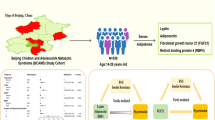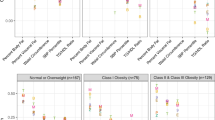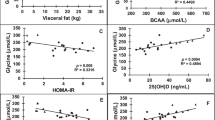Abstract
Objective:
In obesity, adipose tissue becomes a significant source of chemokines and inflammatory cytokines that are associated with chronic systemic low-grade inflammation and may lead to insulin resistance. Studies in children have mainly focused on inflammatory cytokines and there are limited data for chemokines in adolescents and young adults. We studied the relation of chemokines to cardiovascular (CV)-risk factors, insulin resistance and adipocytokines in 18–21-year-old individuals.
Subjects and Design:
Cross-sectional data collected in a cohort originally enrolled at mean age 13, with data for the present study obtained from 252 examined at age 18.7±0.1 years.
Methods:
Multiple linear regression models were used to analyze the associations among chemokines (monocyte chemotactic protein-1, macrophage inflammatory protein-1β (MIP-1β), visfatin and interleukin-8 (IL-8)) and between chemokines and body mass index (BMI), glucose, lipids, blood pressure (BP), insulin resistance (euglycemic hyperinsulinemic clamp) and adipocytokines (IL-6, TNF-α and adiponectin).
Results:
Chemokine levels were significantly intercorrelated. Significant associations (P<0.05) with adjustment for age, race and sex included: MIP-1β with waist circumference and IL-6, IL-8 with systolic BP and visfatin with IL-6. No other significant relations were found between the chemokines and the other variables. Further adjustment for BMI did not alter these conclusions.
Conclusion:
Considered in the context of prior studies in children and adults, these results suggest that in large part, the association between chemokines and CV risk or inflammatory factors does not appear to develop until adult life.
This is a preview of subscription content, access via your institution
Access options
Subscribe to this journal
Receive 12 print issues and online access
$259.00 per year
only $21.58 per issue
Buy this article
- Purchase on Springer Link
- Instant access to full article PDF
Prices may be subject to local taxes which are calculated during checkout
Similar content being viewed by others
References
Luster AD . Chemokines–chemotactic cytokines that mediate inflammation. N Engl J Med 1998; 338: 436–445.
Gerhardt CC, Romero IA, Cancello R, Camoin L, Strosberg AD . Chemokines control fat accumulation and leptin secretion by cultured human adipocytes. Mol Cell Endocrinol 2001; 175: 81–92.
Kim CS, Park HS, Kawada T, Kim JH, Lim D, Hubbard NE et al. Circulating levels of MCP-1 and IL-8 are elevated in human obese subjects and associated with obesity-related parameters. Int J Obes (Lond) 2006; 30: 1347–1355.
Lyon CJ, Law RE, Hsueh WA . Minireview: adiposity, inflammation, and atherogenesis. Endocrinology 2003; 144: 2195–2200.
Zeyda M, Farmer D, Todoric J, Aszmann O, Speiser M, Gyori G et al. Human adipose tissue macrophages are of an anti-inflammatory phenotype but capable of excessive pro-inflammatory mediator production. Int J Obes (Lond) 2007; 31: 1420–1428.
Zeyda M, Stulnig TM . Adipose tissue macrophages. Immunol Lett 2007; 112: 61–67.
Surmi BK, Hasty AH . The role of chemokines in recruitment of immune cells to the artery wall and adipose tissue. Vascul Pharmacol 52: 27–36.
Herder C, Schneitler S, Rathmann W, Haastert B, Schneitler H, Winkler H . et al. Low-grade inflammation, obesity, and insulin resistance in adolescents. J Clin Endocrinol Metab 2007; 92: 4569–4574.
Roth CL, Kratz M, Ralston MM, Reinehr T . Changes in adipose-derived inflammatory cytokines and chemokines after successful lifestyle intervention in obese children. Metabolism 2011; 60: 445–452.
Tam CS, Garnett SP, Cowell CT . Heilbronn LK, Lee JW, Wong M, et al. IL-6, IL-8 and IL-10 levels in healthy weight and overweight children. Horm Res Paediatr 73: 128–134.
Kamei N, Tobe K, Suzuki R, Ohsugi M, Watanabe T, Kubota N et al. Overexpression of monocyte chemoattractant protein-1 in adipose tissues causes macrophage recruitment and insulin resistance. J Biol Chem 2006; 281: 26602–26614.
Davutoglu M, Ozkaya M, Guler E, Garipardic M, Gursoy H, Karabiber H et al. Plasma visfatin concentrations in childhood obesity: relationships with insulin resistance and anthropometric indices. Swiss Med Wkly 2009; 139: 22–27.
Kolsgaard ML, Wangensteen T, Brunborg C, Joner G, Holven KB, Halvorsen B et al. Elevated visfatin levels in overweight and obese children and adolescents with metabolic syndrome. Scand J Clin Lab Invest 2009; 69: 858–864.
Oki K, Yamane K, Kamei N, Nojima H, Kohno N . Circulating visfatin level is correlated with inflammation, but not with insulin resistance. Clin Endocrinol (Oxf) 2007; 67: 796–800.
Moran A, Jacobs DR, Steinberger J, Steffen LM, Pankow JS, Hong CP et al. Changes in insulin resistance and cardiovascular risk during adolescence: establishment of differential risk in males and females. Circulation 2008; 117: 2361–2368.
Torres-Leal FL, Fonseca-Alaniz MH, Rogero MM, Tirapegui J . The role of inflamed adipose tissue in the insulin resistance. Cell Biochem Funct 28: 623–631.
Weisberg SP, Hunter D, Huber R, Lemieux J, Slaymaker S, Vaddi K et al. CCR2 modulates inflammatory and metabolic effects of high-fat feeding. J Clin Invest 2006; 116: 115–124.
Xu H, Barnes GT, Yang Q, Tan G, Yang D, Chou CJ et al. Chronic inflammation in fat plays a crucial role in the development of obesity-related insulin resistance. J Clin Invest 2003; 112: 1821–1830.
Nomiyama T, Perez-Tilve D, Ogawa D, Gizard F, Zhao Y, Heywood EB et al. Osteopontin mediates obesity-induced adipose tissue macrophage infiltration and insulin resistance in mice. J Clin Invest 2007; 117: 2877–2888.
Kanda H, Tateya S, Tamori Y, Kotani K, Hiasa K, Kitazawa R et al. MCP-1 contributes to macrophage infiltration into adipose tissue, insulin resistance, and hepatic steatosis in obesity. J Clin Invest 2006; 116: 1494–1505.
Inouye KE, Shi H, Howard JK, Daly CH, Lord GM, Rollins BJ et al. Absence of CC chemokine ligand 2 does not limit obesity-associated infiltration of macrophages into adipose tissue. Diabetes 2007; 56: 2242–2250.
Sell H, Dietze-Schroeder D, Kaiser U, Eckel J. . Monocyte chemotactic protein-1 is a potential player in the negative cross-talk between adipose tissue and skeletal muscle. Endocrinology 2006; 147: 2458–2467.
Christiansen T, Richelsen B, Bruun JM . Monocyte chemoattractant protein-1 is produced in isolated adipocytes, associated with adiposity and reduced after weight loss in morbid obese subjects. Int J Obes (Lond) 2005; 29: 146–150.
Dahlman I, Kaaman M, Olsson T, Tan GD, Bickerton AS, Wahlen K et al. A unique role of monocyte chemoattractant protein 1 among chemokines in adipose tissue of obese subjects. J Clin Endocrinol Metab 2005; 90: 5834–5840.
Takahashi K, Mizuarai S, Araki H, Mashiko S, Ishihara A, Kanatani A et al. Adiposity elevates plasma MCP-1 levels leading to the increased CD11b-positive monocytes in mice. J Biol Chem 2003; 278: 46654–46660.
Ezenwaka CE, Nwagbara E, Seales D, Okali F, Sell H, Eckel J . Insulin resistance, leptin and monocyte chemotactic protein-1 levels in diabetic and non-diabetic Afro-Caribbean subjects. Arch Physiol Biochem 2009; 115: 22–27.
Nomura S, Shouzu A, Omoto S, Nishikawa M, Fukuhara S . Significance of chemokines and activated platelets in patients with diabetes. Clin Exp Immunol 2000; 121: 437–443.
Gauglitz GG, Herndon DN, Kulp GA, Meyer WJ, Jeschke MG . Abnormal insulin sensitivity persists up to three years in pediatric patients post-burn. J Clin Endocrinol Metab 2009; 94: 1656–1664.
Acknowledgements
This study was supported by the National Institute of Health grants HL-52851 and M01-RR-00400 and by grants from the Minnesota Medical Foundation (MMF) and Children's Cancer Research Fund (CCRF), Minneapolis, Minnesota, USA.
Author information
Authors and Affiliations
Corresponding author
Ethics declarations
Competing interests
The authors declare no conflict of interest.
Rights and permissions
About this article
Cite this article
Ognjanovic, S., Jacobs, D., Steinberger, J. et al. Relation of chemokines to BMI and insulin resistance at ages 18–21. Int J Obes 37, 420–423 (2013). https://doi.org/10.1038/ijo.2012.61
Received:
Revised:
Accepted:
Published:
Issue Date:
DOI: https://doi.org/10.1038/ijo.2012.61
Keywords
This article is cited by
-
LPS response pattern of inflammatory adipokines in an in vitro 3T3-L1 murine adipocyte model
Inflammation Research (2014)



